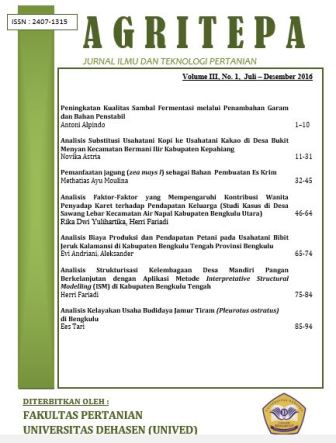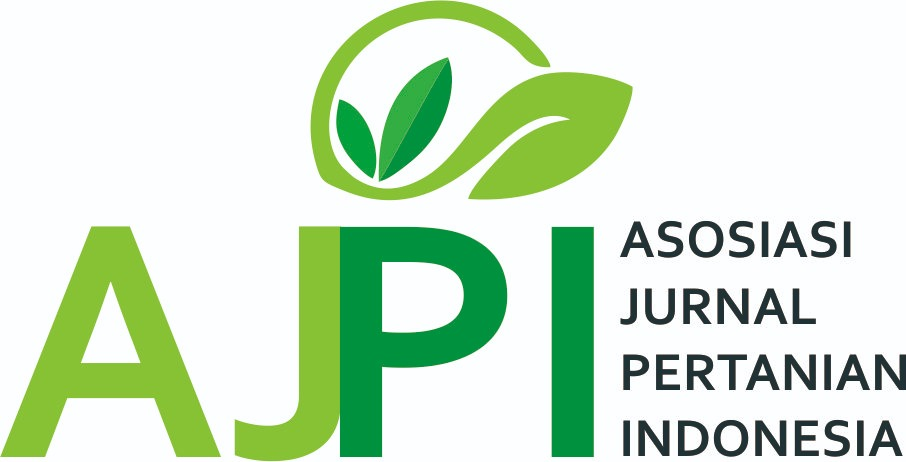Lemea, The Rejang Tribe'S Traditional Food Made From Fermented Bamboo Shoots (Review)
Abstract
Lemea is a traditional food made from fermented chopped bamboo shoots and fish. It is a traditional food of the Rejang tribe in Bengkulu, Sumatera. Lemea is not eaten raw due to its strong flavor and aroma, but rather cooked with simple spices and served with fish or shrimp. It is commonly cooked in a spicy sambal lemea and served as a dish with rice. This review aims to spread information about lemea and its various studies. Several researchers have altered the lemea production process to improve product quality, such as blanching raw materials, fish raw materials, and fermentation containers. The fermentation of lemea is spontaneous fermentation. Lactobacillus plantarum C410L1 and Lactobacillus rossiae LS6 have been identified as lactic acid bacteria from lemea. These bacterial isolates have potential as probiotics because of their good resistance to pH, temperature, and salt concentration.
Downloads
References
Ahmad, A., Yap, W. B., Kofli, N. T., & Ghazali, A. R. 2018. Probiotic potentials of Lactobacillus plantarum isolated from fermented durian (Tempoyak), a Malaysian traditional condiment. Food Science and Nutrition, 6(6), 1370–1377. https://doi.org/10.1002/fsn3.672
Apindis, G.A.M.C., Hanum, S. H., Hartati, S. 2018. Makna Simbolik Tari Kejei Suku Rejang. Jurnal Sosiologi Nusantara, 4(2), 64 – 75
Behera, P., Balaji, S. 2021. Health Benefits of Fermented Bamboo Shoots: The Twenty-First Century Gold of Notheast India. Applied Biochemistry and Biotechnology, 193, 1800-1812
Dewi, K. H., Silsia, D., Susanti, L., & Hasanuddin. 2014. Pemetaan Industri “Lemea” Makanan Tradisional Suku Rejang di Provinsi Bengkulu. Agrisep, 14(1), 61–69.
Dewi, K. H., Zuki, M., & Sustriani, E. 2012. Pemilihan Alat dan Lama Fermentasi pada Proses Pembuatan “Lemea” Makanan Tradisional Suku Rejang. Prosiding Seminar Nasional Fakultas Pertanian Universitas Bengkulu, 339–340.
Dincer, E., & Kivanc, M. 2020. Characterization of Lactobacillus plantarum strains isolated from Turkish pastırma and possibility to use of food industry. Food Science and Technology, Campinas, 40(2), 498–507.
Ivanova, L., Terziyska, I., Trifonova, J., Ivanova, L., Terziyska, I., & Trifonova, J. 2015. Characteristics of traditional food – the viewpoint of the tourism business Char acteristics of tr aditional food – the viewpoint of the tourism business In recent years there has been a clear shift in tourism demand from material expressions of culture t. Journal of Service Management, 4(July), 123–130.
Jenny, G., Indrawati, R. 2017. Analisis Kadar Asam Sianida pada Rebung Sebelum dan Sesudah Pengukusan Selama 10, 15, dan 20 Menit Metode Elektroda Selektif Ion. Jurnal Laboratorium Khatulistiwa, 1, 13-16
Kurnia, M., Amir, H., & Handayani, D. 2020. Isolasi Dan Identifikasi Bakteri Asam Laktat Dari Makanan Tradisional Suku Rejang Di Provinsi Bengkulu: “Lemea.” Jurnal Pendidikan Dan Ilmu Kimia, 4(1). https://doi.org/10.33369/atp.v4i1.13705
Liyoni, D., Dewi, K. H., & Susanti, L. 2020. A study of changes in the quality of Lemea Block in various types of packaging materials during storage. IOP Conference Series: Earth and Environmental Science, 425(1). https://doi.org/10.1088/1755-1315/425/1/012056
Meiniar, E. Lemea Khas Rejang Aromanya Rindu Pulang. Diakses pada 12 Mei 2023 dari https://www.gurusiana.id/read/enimeiniar/article/lemea-khas-rejang-aromanya-rindu-pulang-1973286
Nugroho, N., Bahtiar, E. T., Lelono, A. B. 2022. Kekuatan Bambu Betung (Dendrocalamus asper Backer ex K.Heyne) Menahan Gaya Normal Tekanan dan Tarikan. Jurnal Penelitian Hasil Hutan, 40(1), 37-48
Nurhikmat, A., Suratmo, B., Bintoro, N., & Sentana, S. 2015. PERUBAHAN MUTU GUDEG KALENG “BU TJITRO” SELAMA PENYIMPANAN. Jurnal Agritech, 35(03), 353–357. https://doi.org/10.22146/agritech.9348
Nuryani, Y., Susanti, L., & Dewi, K. H. 2012. Uji Kesukaan Konsumen Terhadap Sambal Lemea Sebagai Makanan Khas Suku Rejang dan Perunahan Mutu Produk pada Berbagai Suhu Penyimpanan. In Agroindustri (Vol. 2, pp. 21–28).
Okfrianti, Y., Herison, C., Fahrurrozi, Budiyanto. 2021. Review : Potensi Rebung untuk Kesehatan. Agritepa, 8(2), 114-122
Okfrianti, Y., Darwis, Muslim, Z., & Kamsiah. 2017. Perbedaan Wadah Fermentasi Lemea Terhadap Total Bakteri Asam Laktat Dan Kadar Protein. Seminar Nasional Perhimpunan Ahli Teknologi Pangan Indonesia (PATPI) - Peran Ahli Teknologi Pangan Dalam Mewujudkan Ketahanan Pangan Nasional, 913–919.
Okfrianti, Y., Darwis, & Pravita, A. 2018. Bakteri Asam Laktat Lactobacillus Plantarum C410LI dan Lactobacillus Rossiae LS6 yang Diisolasi dari Lemea Rejang terhadap Suhu, pH dan Garam Empedu Berpotensi sebagai Prebiotik. Jurnal Ilmu Dan Teknologi Kesehatan, 6(1), 49–58. https://doi.org/10.32668/jitek.v6i1.108
Oktarianto, A., & Widawati, L. 2017. Karakteristik Mutu Sambal Lemea Dengan Variasi Waktu Fermentasi dan Jenis Ikan. 3(2), 57–64.
Rahmawati, A. A. N. 2021. Rebung Bambu Sebagai Alternatif Fitohormon dalam Memacu Pertumbuhan Tunas pada Benih Dorman. Biofarm Jurnal Ilmiah Pertanian, 17(1), 36-39
Reli, R., Warsiki, E., & Rahayuningsih, M. 2017. Modifikasi Pengolahan Durian Fermentasi (Tempoyak) dan Perbaikan Kemasan Untuk Mempertahankan Mutu dan Memperpanjang Umur Simpan. Jurnal Teknologi Industri Pertanian, 27(1), 43–54.
Rikardo, R., Susilo, H., Suyamto. 2015. Etnobotani Bambu Mayan (Gigantochloa robusta Kurz.) di Kecamatan Sobang Pandeglang Banten. J. Schi. Phar, 1(1), 42 – 49
Rocillo-Aquino, Z., Cervantes-Escoto, F., Leos-Rodríguez, J. A., Cruz-Delgado, D., & Espinoza-Ortega, A. 2021. What is a traditional food? Conceptual evolution from four dimensions. Journal of Ethnic Foods, 8(1). https://doi.org/10.1186/s42779-021-00113-4
Senapati, A. K., Pandey, A., Ann, A., Raj, A., Gupta, A., Das, A. J., ... & Joshi, V. 2016. Indigenous fermented foods involving acid fermentation. Indigenuos Fermented Foods of South Asia, Ed. VK Joshi, CRC Press, Taylor & Francis Group, New York, 431-500.
Simanjuntak, B. Y., Suryani, D., Haya, M., & Khomsan, A. 2020. Identification and Farmer Family’s Preference of Indigenous Food in Rural Bengkulu. Jurnal Kesehatan Prima, 14(2), 120–139.
Singhal, P., Satya, S., Naik, S. N. 2021. Fermented Bamboo Shoots : A Complete Nutritional, Anti-Nutritional, and Antioxidant Profile of the Sustainable and Functional Food to Food Security. Food Chemistry : Molecular Sciences, 3, 100041
Vieolanda, N. 2020. Suku Rejang Mengonsumsi Bambu “Lemea”. Diakses pada 12 Mei 2023 dari https://osc.medcom.id/community/suku-rejang-mengonsumsi-bambu-34-lemea-34-997
Yunus, M., Wardhana D. E. C., Sarwono, S. 2020. Fungsi Bahasa pada Wacana Berasan Etnik Rejang di Kabupaten Lebong. Silampari Bisa, 3(2), 391 – 405
Zuidar, A. S., Rizal, S., & Hadi, J. P. O. 2019. Pengaruh preparasi dan blanching terhadap mutu rebung ikan terfermentasi (lemea). Jurnal Teknologi & Industri Hasil Pertanian, 24(1), 39–50.
Zuidar, A. S., Rizal, S., & Widyastuti, K. 2016. Pengaruh Jenis Ikan dan Konsentrasi Garam pada Rebung Ikan Terfermentasi. Jurnal Kelitbangan, 04(02), 181–194.
Copyright (c) 2023 Rozi Satria Utama, Prima Yaumil Fajri, Agustina Agustina, Jerry Antonio

This work is licensed under a Creative Commons Attribution-ShareAlike 4.0 International License.
Author retains the copyright and grants the journal the right of first publication of the work simultaneously licensed under the Creative Commons Attribution-ShareAlike 4.0 License that allows others to share the work with an acknowledgement of the work's authorship and initial publication in this journal













